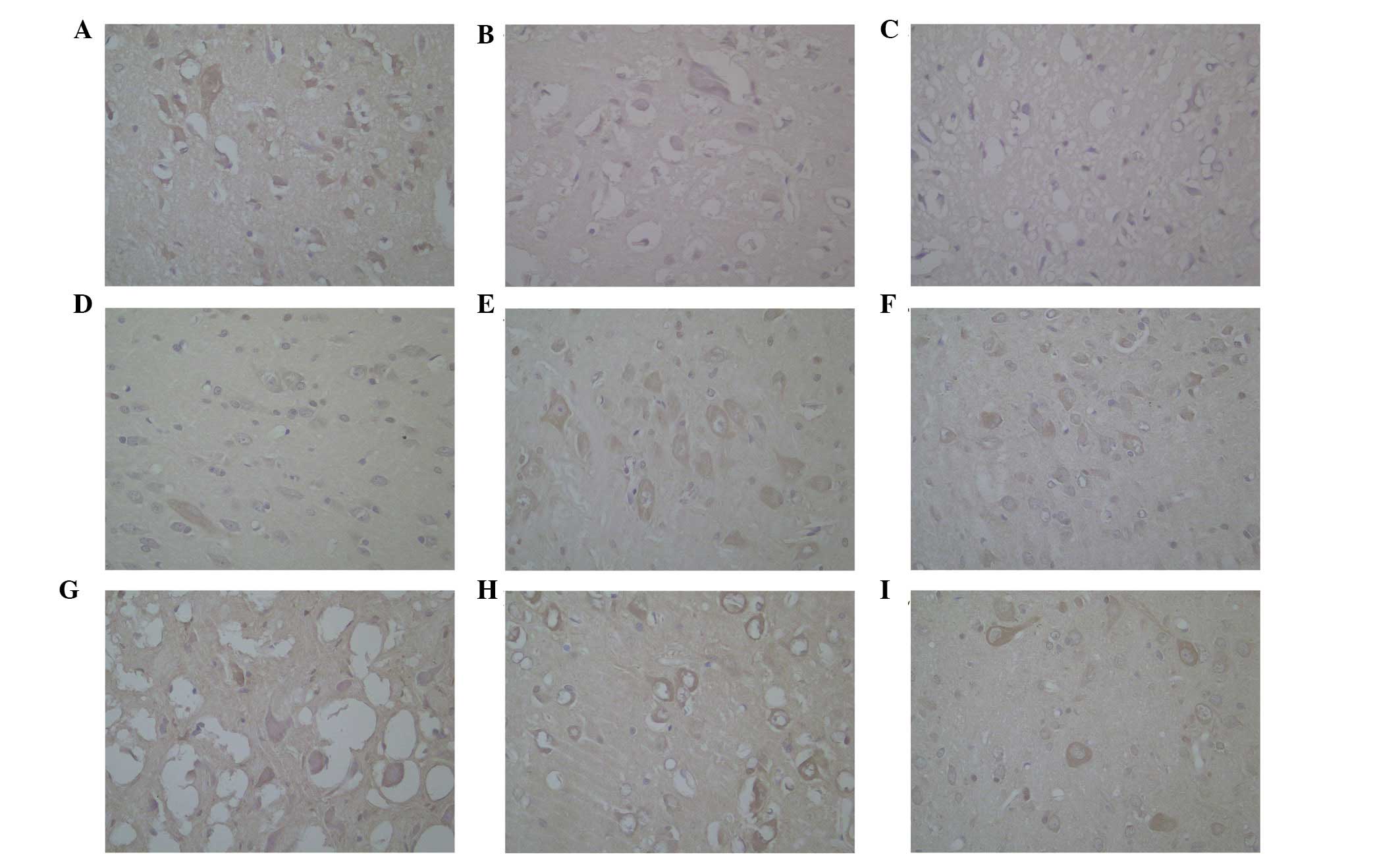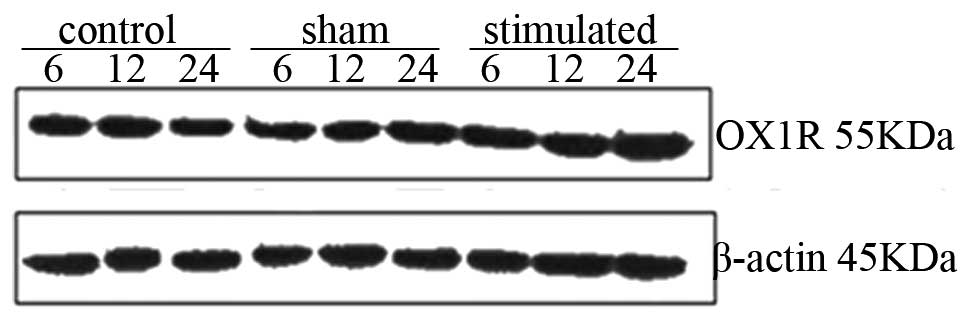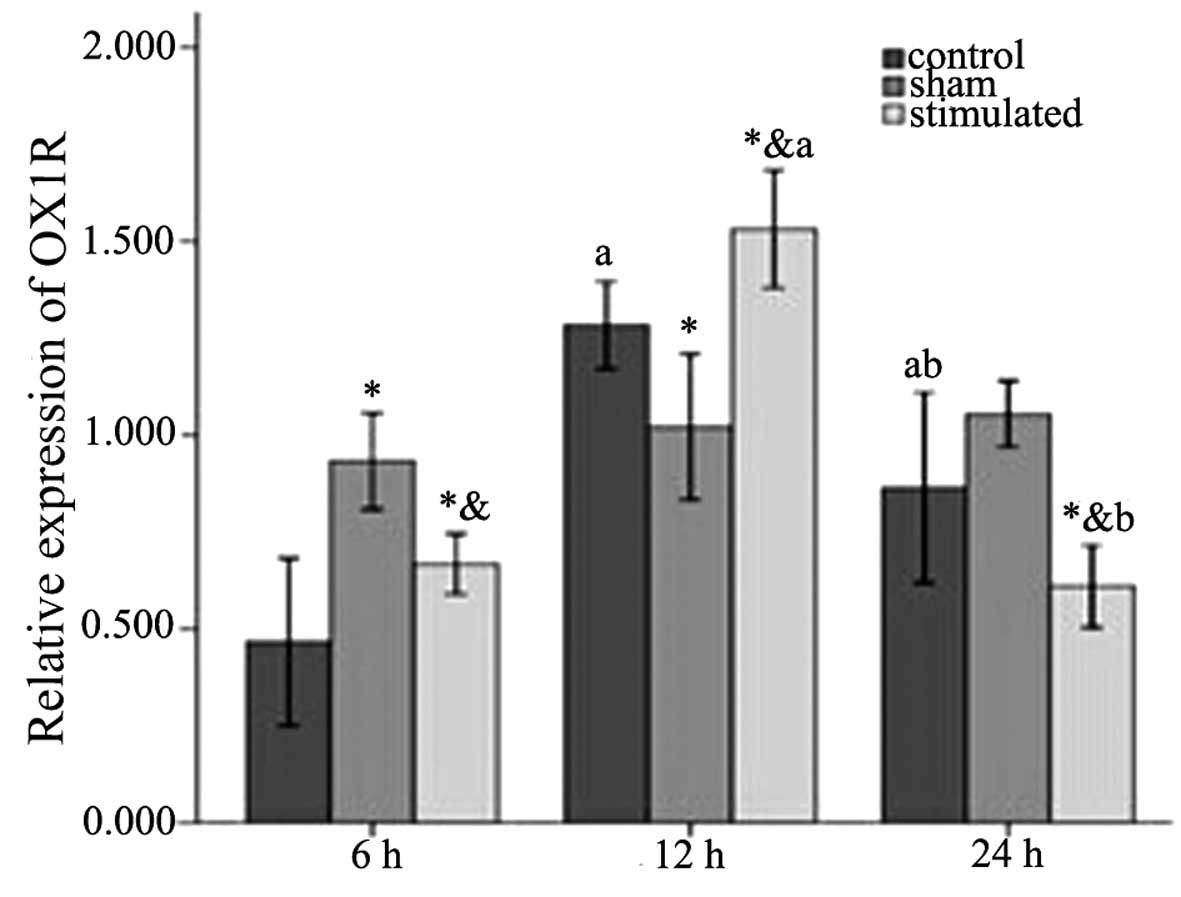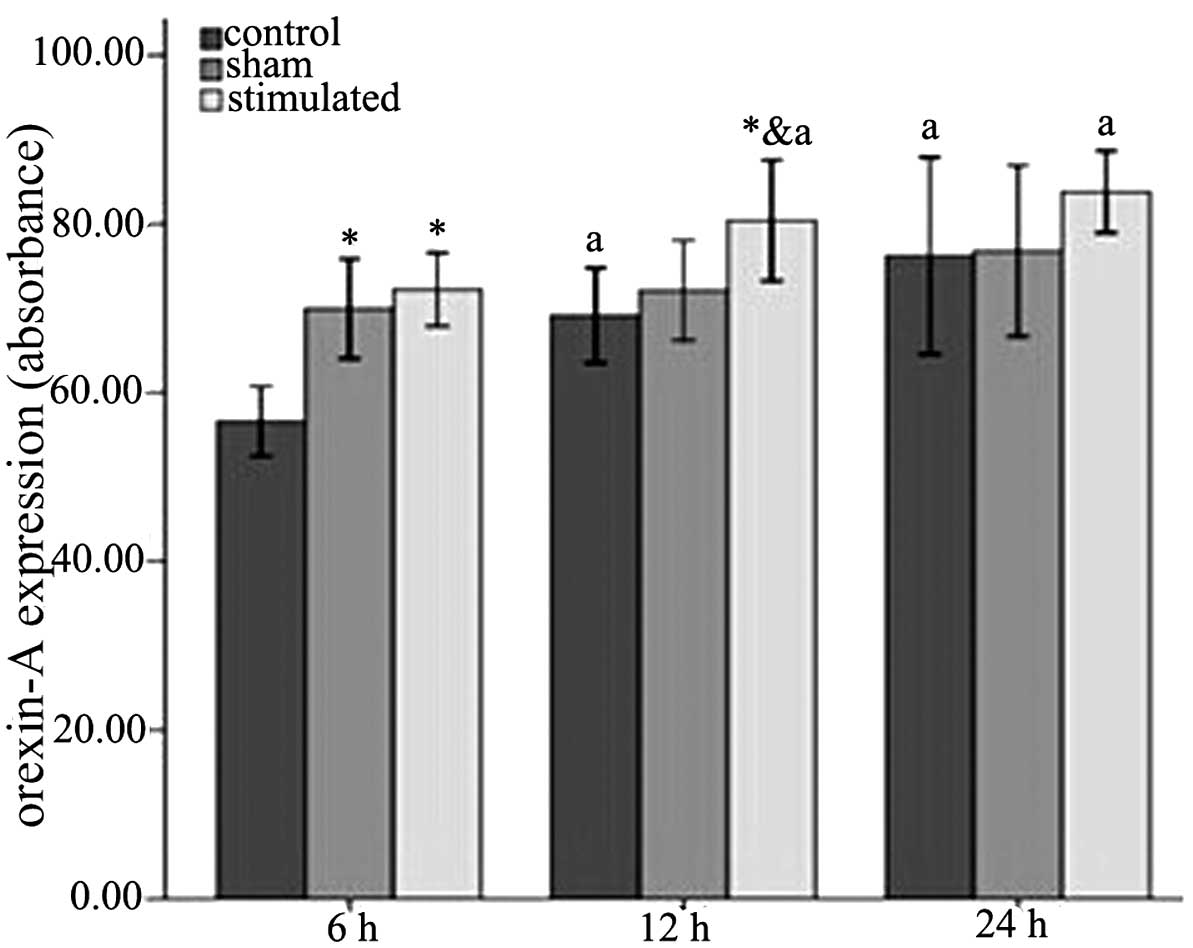|
1
|
Harvey HH: Reducing traumatic brain
injuries in youth sports: youth sports traumatic brain injury state
laws, January 2009–December 2012. Am J Public Health.
103:1249–1254. 2013. View Article : Google Scholar : PubMed/NCBI
|
|
2
|
Rejdak K, Petzold A, Lin L, Smith M,
Kitchen N and Thompson E: Decreased CSF hypocretin-1 (orexin-A)
after acute haemorrhagic brain injury. J Neurol Neurosurg
Psychiatyr. 76:597–598. 2005. View Article : Google Scholar
|
|
3
|
Gao XB and Wang AH: Experience-dependent
plasticity in hypocretin/orexin neurons re-setting arousal
threshold. Acta Physiol (Oxf). 198:251–262. 2010. View Article : Google Scholar
|
|
4
|
de Lecea L: A decade of hypocretins: past,
present and future of the neurobiology of arousal. Acta phyisiol
(Oxf). 198:203–208. 2010. View Article : Google Scholar
|
|
5
|
Peri CV, Shaffrey ME, Farace E, Cooper E,
Alves WM, Cooper JB, Young JS, et al: Pilot study of electrical
stimulation on median nerve in comatose severe brain injured
patients: 3-month outcome. Brain Inj. 15:903–910. 2001. View Article : Google Scholar : PubMed/NCBI
|
|
6
|
Yokoyama T, Kamei T and Kanno T: Right
median nerve stimulation for comatose patients. Soc Treat Coma.
5:117–125. 1996.
|
|
7
|
Suzuki A, Nishimura H, Yoshioka K, et al:
Electrical stimulation of median nerve in patients of prolonged
coma. Soc Treat Coma. 3:75–85. 1994.
|
|
8
|
Moriya T, et al: New therapeutic
strategies for patients with unconsciousness and neurological
deficits in acute stage with median nerve stimulation. Soc Treat
Coma. 7:65–69. 1998.
|
|
9
|
Cooper JB, Jane JA, Alves WM and Cooper
EB: Right median nerve electrical stimulation to hasten awakening
from coma. Brain Inj. 13:261–267. 1999. View Article : Google Scholar : PubMed/NCBI
|
|
10
|
Feeney DM, Boyeson MG, Linn RT, Murray HM
and Dail WG: Responses to cortical injury: I. Methodology and local
effects of contusions in the rat. Brain Res. 211:67–77. 1981.
View Article : Google Scholar : PubMed/NCBI
|
|
11
|
Stephens JR and Levy RH: Effects of
valproate and citrulline on ammoniuminduced encephalopathy.
Epilepsia. 35:164–171. 1994. View Article : Google Scholar : PubMed/NCBI
|
|
12
|
Sakurai T, Amemiya A, Ishii M, Matsuzaki
I, Chemelli RM, Tanaka H, Williams SC, et al: Orexins and orexin
receptors: a family of hypothalamic neuropeptides and G
protein-coupled receptors that regulate feeding behavior. Cell.
92:573–585. 1998. View Article : Google Scholar : PubMed/NCBI
|
|
13
|
Randeva HS, Karteris E, Grammatopoulos D
and Hillhouse EW: Expression of orexin-A and functional orexin type
2 receptors in the human adult adrenals: implications for adrenal
function and energy homeostasis. J Clin Endocrinol Metab.
86:4808–4813. 2001. View Article : Google Scholar : PubMed/NCBI
|
|
14
|
Williams G, Bing C, Cai XJ, Harrold JA,
King PJ and Liu XH: The hypothalamus and the control of energy
homeostasis: different circuits, different purposes. Physiol Behav.
74:683–701. 2001. View Article : Google Scholar
|
|
15
|
Smart D and Jerman J: The physiology and
pharmacology of the orexins. Pharmacol Ther. 94:51–61. 2002.
View Article : Google Scholar : PubMed/NCBI
|
|
16
|
Kukkonen JP, Holmqvist T, Ammoun S and
Akerman KE: Functions of the orexigenic/hypocretinergic system. Am
J Physiol Cell Physiol. 283:C1567–C1591. 2002. View Article : Google Scholar : PubMed/NCBI
|
|
17
|
Taheri S, Ward H, Ghatei M and Bloom S:
Role of orexins in sleep and arousal mechanisms. Lancet.
355:8472000. View Article : Google Scholar : PubMed/NCBI
|
|
18
|
Samson WK, Gosnell B, Chang JK, Resch ZT
and Murphy TC: Cardiovascular regulatory actions of the hypocretins
in brain. Brain Res. 831:248–253. 1999. View Article : Google Scholar : PubMed/NCBI
|
|
19
|
Moreno-Balandrán E, Garzón M, Bódalo C,
Reinoso-Suárez F and de Andrés I: Sleep-wakefulness effects after
microinjections of hypocretin 1 (orexin A) in cholinoceptive areas
of the cat oral pontine tegmentum. Eur J Neurosci. 28:331–341.
2008. View Article : Google Scholar : PubMed/NCBI
|
|
20
|
Peyron C, Tighe DK, van den Pol AN, de
Lecea L, Heller HC, Sutcliffe JG and Kilduff TS: Neurons containing
hypocretin (orexin) project to multiple neuronal systems. J
Neurosci. 18:9996–10015. 1998.PubMed/NCBI
|
|
21
|
Vittoz NM, Schmeichel B and Berridge CW:
Hypocretin/orexin preferentially activates caudomedial ventral
tegmental area dopamine neurons. Eur J Neurosci. 28:1629–1640.
2008. View Article : Google Scholar : PubMed/NCBI
|
|
22
|
Sakurai T, Nagata R, Yamanaka A, Kawamura
H, Tsujino N, Muraki Y, Kageyama H, et al: Input of
orexin/hypocretin neurons revealed by a genetically encoded tracer
in mice. Neuron. 46:297–308. 2005. View Article : Google Scholar : PubMed/NCBI
|
|
23
|
Yoshida K, McCormack S, España RA, Crocker
A and Scammell TE: Afferents to the orexin neurons of the rat
brain. J Comp Neurol. 494:845–861. 2006. View Article : Google Scholar
|
|
24
|
Yamanaka A, Beuckmann CT, Willie JT, Hara
J, Tsujino N, Mieda M, Tominaga M, et al: Hypothalamic orexin
neurons regulate arousal according to energy balance in mice.
Neuron. 38:701–713. 2003. View Article : Google Scholar : PubMed/NCBI
|
|
25
|
Cossu G: Therapeutic options to enhance
coma arousal after traumatic brain injury: State of the art of
current treatments to improve coma recovery. Br J Neurosurg.
28:187–198. 2014. View Article : Google Scholar
|
|
26
|
Cooper EB and Cooper JB: Electrical
treatment of coma via the median nerve. Acta Neurochir Suppl.
87:7–10. 2003.PubMed/NCBI
|
|
27
|
Liu JT, Wang CH, Chou IC, Sun SS, Koa CH
and Cooper E: Regaining consciousness for prolonged comatose
patients with right median nerve stimulation. Acta Neurochir Suppl.
87:11–14. 2003.PubMed/NCBI
|
|
28
|
Cooper EB, Scherder EJ and Cooper JB:
Electrical treatment of reduced consciousness: Experience with coma
and Alzheimer's disease. Neuropsychol Rehabili. 15:389–405. 2005.
View Article : Google Scholar
|
|
29
|
Liu JT, Lee JK, Tyan YS, Liu CY and Lin
TB: Change in cerebral perfusion of patients with coma after
treatment with right median nerve stimulation and hyperbaric
oxygen. Neuromodulation. 11:296–301. 2008. View Article : Google Scholar : PubMed/NCBI
|
|
30
|
Sauvage M and Steckler T: Detection of
corticotrophin-releasing hormone receptor 1 immunoreactivity in
cholinergic, dopami-nergic and noradrenergic neurons of the murine
basal forebrain and brainstem nuclei-potential implication for
arousal and attention. Neuroscience. 104:643–652. 2001. View Article : Google Scholar
|
|
31
|
Kayama Y and Koyama Y: Brainstem neural
mechanisms of sleep and wakefulness. Eur Urol. 33:12–15. 1998.
View Article : Google Scholar : PubMed/NCBI
|
|
32
|
Butler MP, Rainbow MN, Rodriguez E, Lyon
SM and Silver R: Twelve-hour days in the brain and behavior of
split hamsters. Eur J Neurosci. 36:2556–2566. 2012. View Article : Google Scholar : PubMed/NCBI
|
|
33
|
Belle MD, Hughes AT, Bechtold DA,
Cunningham P, Pierucci M, Burdakov D and Piggins HD: Acute
suppressive and long-term phase modulation actions of orexin on the
mammalian circadian clock. J Neurosci. 34:3607–3621. 2014.
View Article : Google Scholar : PubMed/NCBI
|
|
34
|
Donjacour CE, Kalsbeek A, Overeem S,
Lammers GJ, Pévet P, Bothorel B, Pijl H and Aziz NA: Altered
circadian rhythm of melatonin concentrations in
hypocretin-deficient men. Chronobio Int. 29:356–362. 2012.
View Article : Google Scholar
|
|
35
|
Yan A, Zhang L, Tang Z, Zhang Y, Qin C, Li
B, Li W and Lin H: Orange-spotted grouper (Epinephelus coioides)
orexin: molecular cloning, tissue expression, ontogeny, daily
rhythm and regulation of NPY gene expression. Peptides.
32:1363–1370. 2011. View Article : Google Scholar : PubMed/NCBI
|













